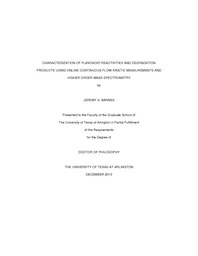| dc.description.abstract | Epidemiological studies offer strong evidence that diets rich in fruits and vegetables provide a defense against cardiovascular disease, cancer and other physiological disorders. One theory suggests that these hazards are due in part to an imbalance of the body's oxidative load, caused by an increase in biologically-relevant free radicals, such as reactive oxygen species (ROS). Flavonoids, a family of plant metabolites, are associated with an antioxidant capacity which could reduce oxidative stress and aging. Quercetin, a flavonol with one of the highest rated antioxidant characteristic, was used as a model system to evaluate the reactivity of flavonoids in the presence of ROS under physiological conditions.Degradation pathways induced by thermal degradation, reaction with hydrogen peroxide and reaction with azo-initiated free radicals were followed using continuous flow kinetics and mass spectrometry (MS). An in-house built online continuous flow device, constructed of concentric capillary tubes and modified to fit the inlet of a photodiode array (PDA) and MS detector, provided time-resolved measurements of degradation of quercetin and the ability to track formation of intermediate degradation products. Reactant concentrations and reaction time could be varied by adjustments to the flow speeds and to the volume of the reaction chamber. Identification and structural elucidation of intermediates and degradation products were aided by high mass accuracy and the use of multi-dimensional tandem mass spectrometry(up to MS3). Computational modeling was used to investigate the reactive sites of quercetin.Based on the findings herein, a few conclusions regarding oxidative degradation of quercetin, which have been established in previous literature, were confirmed. First, it was concluded that regardless of the oxidant source, oxidative degradation of quercetin followed first order kinetics. Second, the oxidative pathway involved formation of o-quinones and semiquinones through electron transfer steps, followed by solvent adducts generated by nucleophilic attack. Lastly, the end products of oxidative degradation were smaller weight phenolic acids.Adding to that, this work demonstrated that oxidative degradation of quercetin was quite complex and that numerous species (>20) were observed in aqueous solutions. Depending on the oxidant source, different solvent adducts were formed. These solvent adducts were intermediates which lead to different smaller weight phenolic acids. Under auto-oxidative conditions, a chalcantrione species was formed, which lead to 2,4,6-trihydroxymandelate and 2,4,6-trihydroxyglyoxylate, while, in the presence of hydrogen peroxide, a cyclic peroxidation adduct was formed, which lead to a depside intermediate followed by formation of 2,4,6-trihydroxybenzoate. Furthermore, in the presence of an azo-initiated free radicals, a peroxyl adduct was observed, as well as phenolic acids that were common to autoxidation and hydrogen peroxide-induced oxidation. However, use of the azo-compounds also generated numerous unrelated side reactions. | en_US |


